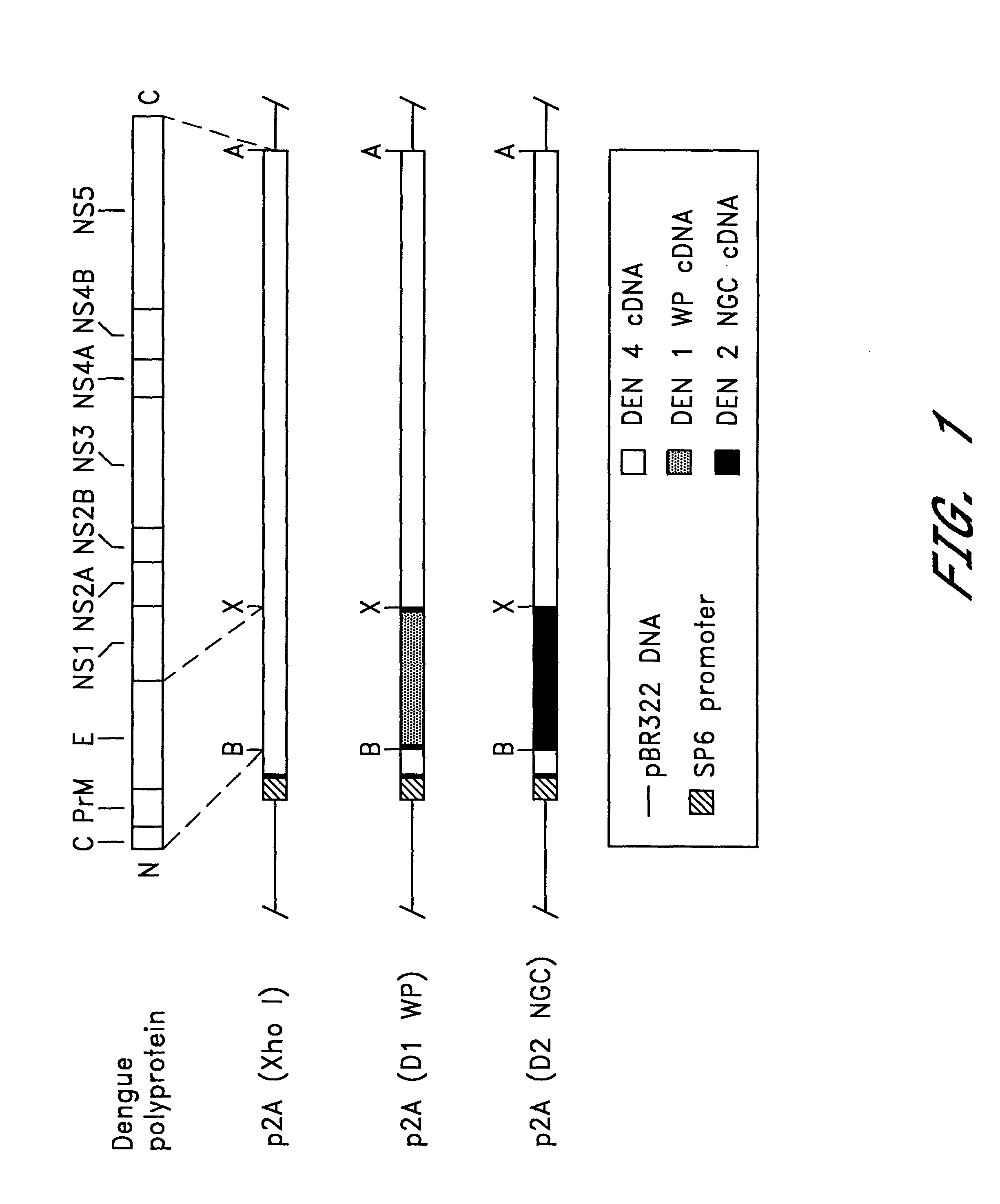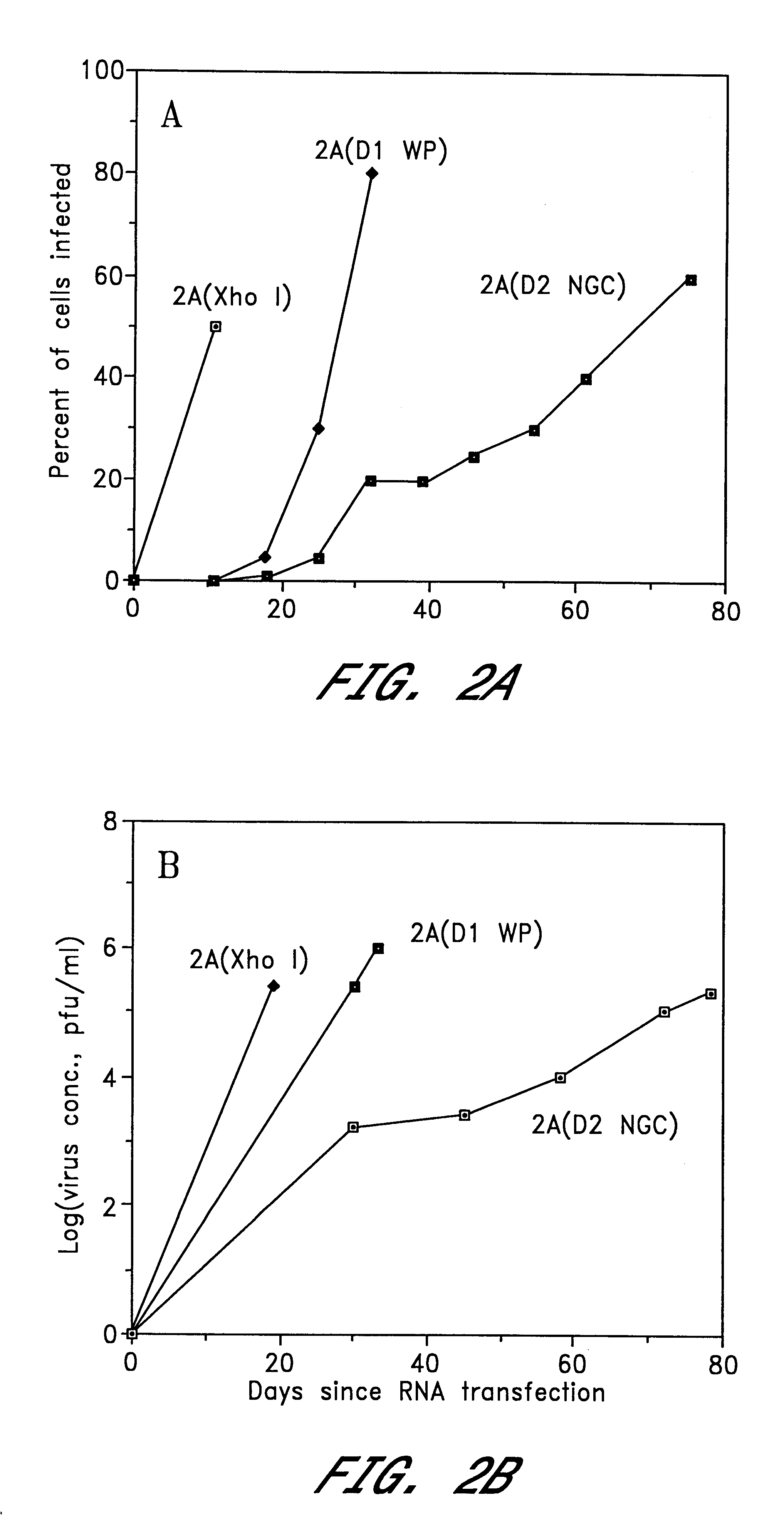Chimeric and/or growth-restricted flaviviruses
- Summary
- Abstract
- Description
- Claims
- Application Information
AI Technical Summary
Problems solved by technology
Method used
Image
Examples
example 1
Chimeric cDNA & Viruses
The full-length dengue type 4 virus cDNA (p2A) was used to construct chimeric viruses in which its structural gene sequences were replaced by the corresponding sequences of a dengue type 1 or type 2 virus. The type 1 virus (WP) chosen for this purpose was a low tissue culture passage strain that had not been adapted to growth in mouse brain. The type 2 strain (NGC) was a highly neurovirulent mutant that had been selected during serial intracerebral passage in mice. The type 2 mutant was chosen for this study because it offered the possibility of mapping the genetic determinants of mouse neurovirulence.
Transformation of E. coli strain HD1528 bacteria with plasmid constructs p2A (Xho I), p2A (D1 WP) or p2A (D2 NGC) produced a stable plasmid population. The predicted structure of these plasmids is shown in FIG. 1. Their structure was verified by restriction enzyme mapping.
Approximately one-half of the LLC-MK.sub.2 cells transfected with RNA transcripts from p2A (...
example 2
Characterization of Chimeric Structural Proteins
Indirect immunofluorescence was performed to characterize progeny viruses, as shown in FIG. 3.
FIG. 3 presents immunofluorescence assay performed on LLC-MK.sub.2 cells infected with v2A (Xho I), v2A (D1 WP), or v2A (D2 NGC), or on uninfected cells. Monoclonal antibodies were used at dilutions of 1:50-1:300, while fluorescein-conjugated anti-mouse antibody was used at 1:100. The serotype specificity of the monoclonal antibodies is shown at left.
Cells infected with v2A (Xho I) were stained with dengue 4 specific mab 1H10 by IFA, but did not bind dengue 1 specific mab 1 Fl or dengue 2 specific mab 3M5. As predicted, cells infected with v2A (D1 WP) reacted only with 1F1, and those infected with v2A (D2 NGC) were stained only with 3H5. Mab 5D4, specific for dengue 3 virus, did not react with any of the infected cells. These results indicated that both chimeric viruses exhibited the antigenicity specified by their structural protein genes. As...
example 3
Virulence of Viruses for Suckling Mice
Chimera v2A (D2 NGC) was compared with its parental viruses, mouse-brain adapted dengue 2 NGC and v2A (Xho I), for mouse neurovirulence. Dengue 2 NGC proved to be the most rapidly lethal: each of 10 mice died of encephalitis on day 5 or day 6 post-inoculation, with a mean survival time of 5.1 days, while each of the 15 mice inoculated with chimera v2A (D2 NGC) survived 8-11 days before dying, with a mean survival time of 9.1 days (FIG. 6).
FIG. 6 presents three-day-old Swiss mice inoculated intracerebrally with 2000 pfu of either parental or chimeric dengue virus, in the form of a diluted lysate of infected LLC-MK.sub.2 cells. The number of mice injected was: dengue 2 (NGC), 10 mice; v2A (D2 NGC), 15; dengue 4 814669, 12; v2A (Xho I), 18. Negative controls (11 mice) were injected with a diluted lysate of uninfected cells. Mice were then monitored daily for signs of encephalitis and for death.
The difference in survival distributions is significant...
PUM
| Property | Measurement | Unit |
|---|---|---|
| Length | aaaaa | aaaaa |
| Composition | aaaaa | aaaaa |
| Concentration | aaaaa | aaaaa |
Abstract
Description
Claims
Application Information
 Login to View More
Login to View More - R&D
- Intellectual Property
- Life Sciences
- Materials
- Tech Scout
- Unparalleled Data Quality
- Higher Quality Content
- 60% Fewer Hallucinations
Browse by: Latest US Patents, China's latest patents, Technical Efficacy Thesaurus, Application Domain, Technology Topic, Popular Technical Reports.
© 2025 PatSnap. All rights reserved.Legal|Privacy policy|Modern Slavery Act Transparency Statement|Sitemap|About US| Contact US: help@patsnap.com


